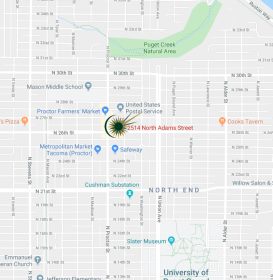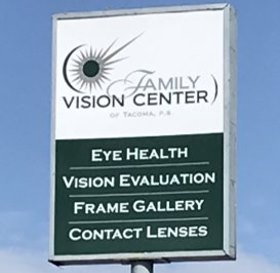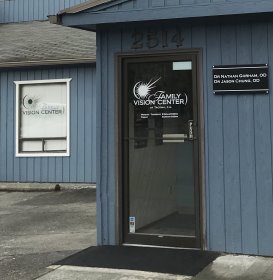Vision Over 40
By the time we reach our fourth decade, many of us find ourselves managing others and sitting in front of a computer more often than we did earlier in our lives. And then, ironically, at the very time our vision demands are more exacting up close than they have been before, it starts to be harder to focus up close! For many of us, there is a great deal of psychological resistance to the prospect of aging to begin with, but to make matters worse, turning 40 is a milestone often used as an excuse for friends and family to make fun! For these and many other reasons, people avoid making their first appointment to an eye doctor’s office even when the eye doctor is their best ally in helping adapt vision around new challenges.
Presbyopia
It is not inevitable that ‘our eyes get worse’ as we get older, but our loss of ability to focus up close is. This vision condition is called presbyopia, which is different than nearsightedness or farsightedness, which refer to distance vision. So though there are people who see crisply their whole lives, they will need some lenses to compensate for this lack of adjustability up close.
Ideally, the human vision system is at rest at a distance of 20 feet or more, and must add another two or more diopters of optical power to bring things into focus at a reading distance. From roughly age ten on, our eyes gradually lose their ability to adjust to near working distances (even though it can seem as though near vision is suddenly lost in our forties!) There are no exercises, vitamins or medications to make this better or help it improve significantly: the reason this happens is because of changes in the optics of our eyes.
The crystalline lens, located behind the iris, is the structure responsible for adding in optical power to our vision systems. It is suspended under tension like a trampoline, attached to a sphincter muscle around it which can let off the tension to allow the lens to become more spherical in shape. This is what adds the optical power necessary to see up close. The lens gradually grows in size all our lives, however, eventually letting off enough tension that it cannot flex enough to focus. This impacts people differently depending on what kind of distance prescription they are starting from.
Remember that at a distance of 20 feet or more the eyes are ideally at rest, and ‘reel in’ power as needed when focusing on objects closer up. The terms ‘nearsighted’ or ‘farsighted’ STRICTLY refer to the far vision, describing whether the system has too much or too little optical power at distance: if there is too much, it is as though we ‘cast’ our vision too close, and cannot push the focal point back out; if there is too little power built into our systems, it is as though we ‘cast’ our vision too far and have to rely on our focusing system to ‘reel in’ more power to put it in the right place. Prescription lenses simply add or subtract optical power to mimic the ideal optical situation, which is to put the eyes at rest. So, if a nearsighted person loses their ability to focus, often you will see them peek below their glasses or take them off because it is as though their eyes are built like reading glasses, and now looking through a prescription lens that pushes the focal point out farther makes their near vision blurry. And, if a farsighted person loses their ability to focus, eventually it affects their distance vision because they have unknowingly been using up some of their focusing range to compensate for their lack of power at distance. When a person has the ideal amount of optical power, and is neither nearsighted nor farsighted, this is called Emmetropia. These people need correction only for near situations. In any case, Presbyopia changes the way we function when focusing between far and near working distances.
Prescription Lenses
The disadvantage to single-vision (single-focus) lenses for presbyopia is their inability to give more than one place at which things are in focus. This is why a family of lenses called Multifocals is popular: they can provide vision at more than one ‘seeing’ distance. (See Eyeglasses article.) Most of us with presbyopia eventually acquire one of these wonderful tools for our lives because they are practical: put them on, and all parts of your world are clear. Still, single-vision lenses are often added for certain situations like working at a computer, because the advantage of multifocal lenses is also sometimes a downside: there is less room in multifocal lenses for each working distance.
Still another excellent tool to use can be contact lenses. In addition to freedom from glasses, they can provide some vision advantages in some cases. In all cases, however, we think that all vision correction options should be kept on the table and used creatively to provide comfortable vision in as natural and practical a way as possible.
"Reader" Glasses
The glasses available in retail stores without a prescription may ‘get you back in the game’, but the manufacturing techniques required for mass-producing such products don’t allow for the degree of precision to correct vision as well as should be - particularly given our increased need for crisp, comfortable vision. (See Eyeglasses article.) As ‘one size fits all’ devices, they lack correction for astigmatism, or for differences in power from one eye to the other, and many other optical considerations. This makes wearing these devices often much less comfortable. And, as single-vision lenses, they must be removed for distance, making them less practical. Countless patients complain of buying multiple pairs of these, none of which they can find when needed! They come into our office to relent and get ‘some glasses they can just put on’, seeing it as a sign of finally throwing in the towel! Given the degree of comfort and practicality possible, it puzzles many of us that they don’t seek out tailor-made prescription lenses first and skip the inconvenient intermediate stage! Granted, one can be more careless with cheap glasses, but more often than not, "you get what you pay for".
Consider also that ocular disease happens at a higher rate when we are over 40. Getting a complete eye examination should be done even to simply rule this out. Call us today to set up an appointment at (253) 759-5679.
Though every effort has been made to be accurate, all articles contained within this website are for strictly informational purposes, and not to be used as a sole source for healthcare training and instruction. Neither does Family Vision Center of Tacoma, P.S., assume responsibility for actions undertaken by someone using information presented on this website to make healthcare decisions.
Glowing Reviews
I want to thank Dr, Gorham for seeing me so quickly. You were the exactly perfect blend of kindness and thoroughness. Thank you!
Deana, Fife, WA
Wow! Many thanks for making my first visit so memorable. Dr Gorham and the staff were organized, informative, and helpful throughout my exam, paperwork, and selection process. I am very pleased and will tell everyone
Wade, Tacoma
Terrific customer service, warm and caring. Beyond the above mentioned kudos, the technical knowledge of products was A+. Will recommend your office!
Kathy, Tacoma
Everyone was great and served me very attentively. Thank you very much for listening to my concerns and helping me all the way from a thorough exam to picking a pair of glasses that work perfectly for me! What a relie
Lorrie, Tacoma
I was very pleased with the way I was treated, and how everything was explained to me. I’m looking forward to my next visit! (And I’m enjoying my headache-free days at school!) Thanks again!
Jessica, Tacoma





